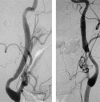Carotid artery stenting to prevent stroke in a patient with bilateral extracranial internal carotid dissection and vasospasm following rupture of an intracranial aneurysm
- PMID: 20591257
- PMCID: PMC3548216
- DOI: 10.1177/159101990300900311
Carotid artery stenting to prevent stroke in a patient with bilateral extracranial internal carotid dissection and vasospasm following rupture of an intracranial aneurysm
Abstract
The stenting of carotid dissection has been described for the prevention of cerebral ischemia in patients who remain symptomatic despite therapeutic anticoagulation, in those who present contraindications for anticoagulation therapy, or who present a local or extensive stenosis, with an associated pseudoaneurysm. We here report a case associating a high clinical grade aneurysmal rupture with a bilateral extracranial carotid dissection. Because of the haemodynamic risk due to the acute bilateral stenosis-induced dissection and the occurrence of a vasospasm, the carotid dissections were treated with self-expendable stents.
Figures





Similar articles
-
Extracranial-Intracranial High-Flow Bypass for Giant Ruptured Paraclinoid Aneurysm with Concomitant Bilateral Internal Carotid Artery Stenotic Dissection.World Neurosurg. 2018 Sep;117:265-270. doi: 10.1016/j.wneu.2018.06.101. Epub 2018 Jun 21. World Neurosurg. 2018. PMID: 29936212
-
Symptomatic spontaneous intracranial carotid artery dissection treated with a self-expanding intracranial nitinol stent: a case report.Surg Neurol. 2009 May;71(5):604-9. doi: 10.1016/j.surneu.2007.11.021. Epub 2008 Mar 3. Surg Neurol. 2009. PMID: 18313734
-
[Treatment of patients with a cerebral arterial aneurysm and stenosis of the internal carotid artery].Angiol Sosud Khir. 2020;26(4):79-84. doi: 10.33529/ANGI02020408. Angiol Sosud Khir. 2020. PMID: 33332309 Russian.
-
Stenting and prevention of ischemic stroke.Curr Drug Targets. 2007 Jul;8(7):867-73. doi: 10.2174/138945007781077445. Curr Drug Targets. 2007. PMID: 17630941 Review.
-
The role of carotid artery stenting for recent cerebral ischemia.J Cardiovasc Surg (Torino). 2010 Jun;51(3):293-304. J Cardiovasc Surg (Torino). 2010. PMID: 20523278 Review.
Cited by
-
Stent-Assisted Angioplasty in Spontaneous Bilateral Extracranial Internal Carotid Artery Dissection.Front Neurol. 2020 Nov 13;11:582253. doi: 10.3389/fneur.2020.582253. eCollection 2020. Front Neurol. 2020. PMID: 33281719 Free PMC article.
-
Primary stent implantation for bilateral spontaneous cervical ICA dissections with hypoperfusion after 72 h from onset: a case report.CVIR Endovasc. 2022 Aug 13;5(1):40. doi: 10.1186/s42155-022-00318-x. CVIR Endovasc. 2022. PMID: 35962854 Free PMC article.
-
Spontaneous Bilateral Cervical Internal Carotid Artery Dissection Treated with Simultaneous Bilateral Carotid Artery Stenting: A Case Report.NMC Case Rep J. 2019 May 25;6(3):71-74. doi: 10.2176/nmccrj.cr.2018-0257. eCollection 2019 Aug. NMC Case Rep J. 2019. PMID: 31417834 Free PMC article.
References
-
- Bougousslavsky J, Regli F. Ischemic stroke in adults younger than 30 years of age. Cause and prognosis Arch Neurol. 1987;44:479–482. - PubMed
-
- Leys D, Lucas C, et al. Cervical artery dissections. Eur Neurol. 1997;37:3–12. - PubMed
-
- Dorsch NWC. Nimodipine and cerebral vasospasm: review of effects and mechanisms. In: Pasqualin A, Da Pian R, editors. New Trends in Management of Cerebrovascular Malformations. Wien: Springer-Verlag; 1994. pp. 95–98.
-
- Schievink WI, Mokri B, Whisnant JP. Internal carotid artery dissection in a communit. Rochester, Minnesota 1987-1992. Stroke. 1993;24:1678–1680. - PubMed
-
- Milandre L, Perot S, et al. Spontaneous dissection of both extracranial internal carotid arteries. Neuroradiology. 1989;31:431–439. - PubMed
LinkOut - more resources
Full Text Sources

